Wartime Heritage
ASSOCIATION

copyright © Wartime Heritage Association
Website hosting courtesy of Register.com - a web.com company
Captain John “Jack” Howell – Unsung Yarmouth Hero
Captain John “Jack” Howell – Unsung Yarmouth Hero
By Michael Cunningham
Captain Jack Howell was born in New Brunswick, 16 October 1903. Little information is available about his
early years, but it would seem Jack Howell went to sea when he was quite young. Prohibition in the US
between 1920 and 1937 made rum-running a financially attractive but risky venture for many fishermen.
Yarmouth was the home port for many of the rum-running operations along the eastern US coastline. Jack
Howell became one of the best-known rum running captains. A brave man known to accept most risks, Jack’s
adventures gained him significant experience in the coastal waters of Nova Scotia and New England. Little did
he know this experience would shape his legacy the way it did.
As the prospect of war with Germany grew in the mid-thirties the Royal
Canadian Air Force (RCAF) began building up their operations on Canada’s east
coast. In addition to air bases, like the one at Yarmouth, the RCAF built many
coastal outposts, like radar sites and observation stations for offshore practice
bombing ranges. One practice bombing range for the RCAF in Yarmouth was off
the shores of Port Maitland. To help meet their needs, the RCAF needed their
own navy to provide transportation, supply, search, and rescue operations. For
these reasons, the RCAF’s 102 Marine Squadron (102MS) was formed.
In the beginning in 1939, 102MS used whatever boats they could get their hands
on. Many of the first boats were former rum-running vessels, Cape Island fishing
boats, yachts, and even open boats with outboard motors. Boat crews played
several important supporting roles, placing moorings, supplying coastal bases,
towing targets for training, patrolling target ranges for stray fishing boats and
many other tasks. A few larger vessels were used to transport RCAF cargos to
bases and outposts in Newfoundland and Labrador. Once the war started
purpose-built, high-speed patrol boats were added to the fleet. Many of these
boats were built in England and Canada but several were obtained from the US.
Many of these later boats were 80 ft vessels resembling the US style PT boats.
Referred to locally in Canada as “crash” boats, the boat crews played a role in
many successful rescues. They were a welcome site to unlucky pilots who found
themselves afloat in a little rubber dingy after a ditching at sea, soaked to the
skin and freezing. Often the conditions these brave boat crews went out in were
very bad and extremely risky. Wind, heavy seas, rain, snow and fog often made
finding lost airmen very difficult even for the experienced seamen operating the
crash boats.
By the start of 1941 102MS had tripled in size with approximately 165 boats and
450 personnel. The commanding officer of the Dartmouth Marine Squadron
headquarters was F/L Jack “Machine Gun” Kelly, a 102 Marine Squadron crest
Yarmouth based “crash” boats former RCMP officer who carried a Thompson
machine gun during prohibition. 102 MS needed sailors with extensive inshore
coastal experience like the former smugglers of the rum running days and F/L
Jack Kelly named, one of the best known, Jack Howell as his second in
command. When F/L Kelly left 102MS, Jack Howell was promoted to Squadron
Leader (SL) and put in charge of the entire east coast Air Force Marine 102
Squadron. Some members of 102 MS are shown in the adjacent picture. Jack
Howell is seated in the first row, second from the right.
Jack Howell more than did his part during WWII, serving with distinction. He received honorable mention several times, but his
most famous exploits occurred during the voyage of the 164 ft supply vessel Eskimo from Dartmouth to Iceland in the middle of a
bleak Atlantic winter.
The battle of the Atlantic against German U-boats had taken a turn from earlier years. During the winter of 1943-44 German subs
began to focus their operations in the mid-Atlantic out of range for east coast based sub hunting aircraft. To close this mid-Atlantic
gap, the Yarmouth based 162BR squadron equipped with the long-range Canso was selected providing protective air cover for
allied convoys. Not only did the aircraft have to fly to their new base in Reykjavik, Iceland but all the support personnel and every
piece of equipment and spare parts had to go by sea. This task fell on the shoulders of Squadron Leader Jack Howell, the men,
and ships of the 102MS.
The Eskimo under the command of Jack Howell left Dartmouth loaded with
men and equipment 12 January 1944. Built for coastal waters the Eskimo
would take on the hazardous 4000-mile journey through the worst North
Atlantic weather in years. The men of the Eskimo battled dangerous ice
accumulation on the ship, 70 mile an hour winds and waves as high as 50 to 60
feet. The first leg of the trip to Newfoundland was uneventful but after leaving
St John’s a serious fire broke out in the ship’s galley. With the Eskimo struggling
in heavy seas the crew spent anxious moments fighting the fire. Luckily, with
some heroic effort the flames were extinguished. The Eskimo was forced 200
miles of course by fierce gales and seas that swept the decks seriously
pounding the superstructure. Just when they thought they were out of danger, approaching Reykjavik the Eskimo passed close to
a floating mine could have blown the ship out of the water.
Jack Howell reported that the Eskimo’s crew had performed exceptionally in very dangerous conditions even though there was
hardly a dry spot to be found for sleeping. Jack said he had found the cook baking bread in the galley while the floor under him
was awash with several inches of water, ashes and other debris. Even after the galley fire the cook never failed to provide the
men with hot meals.
After the war Jack Howell returned to Yarmouth going to work again as a
fishing boat skipper. In 1947 Captain Jack was involved in the salvage of a
75-foot fishing trawler from Gloucester Mass which went aground in
Yarmouth Harbour. The Dorothy & Ethel was seeking shelter from a heavy
southeasterly gale and blinding rainstorm. The vessel struck Gunner’s
Point at John’s Cove head-on and immediately RCAF supply vessel Eskimo
began filling with water. The crew climbed aboard a dory and safely made
their way to the sandy beach of John’s Cove. Captain Jack Howell in
command of the dragger Norway salvaged the Dorothy & Ethel 11
November 1947. He had her repaired and renamed her, the Barbara
Howell.
Jack Howell died of a heart attack 26 February 1951 aboard the Barbara
Howell as he made his way up Yarmouth harbour passing by the Bug
Light. Given Jack Howell’s incredible life story, passing away at the wheel
of the Barbara Howell was likely an end he would have accepted.

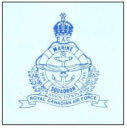
102 Marine Squadron crest
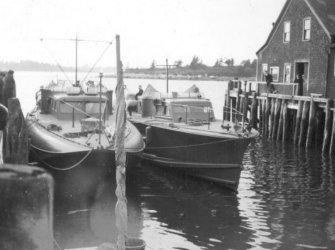
Yarmouth based “crash” boats
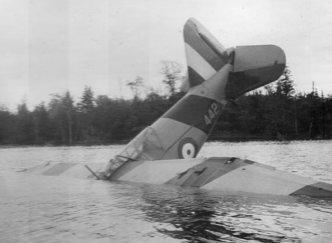

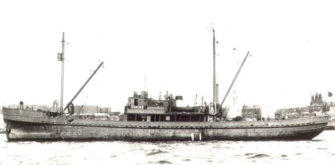
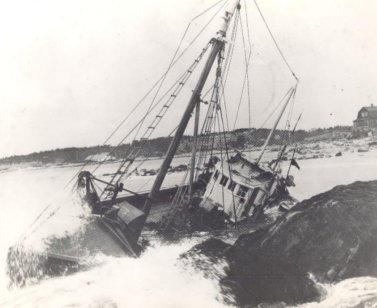
RCAF supply vessel Eskimo
Dorothy & Ethel on the rocks at John’s Cove


- World War I - Menu
- WWI Stories and Articles
- Photos - Yarmouth Soldiers
- Selection of World War I Songs
- WWI Casualties of Yarmouth, NS
- Those Who Served - Yarmouth, NS
- WWI Casualties Digby Co. NS
- WWI Casualties Shelburne Co. NS
- Merchant Mariners (1915) Yarmouth, NS
- Canadian Forestry Corps - Non Yarmouth Birth/Residence Enlistments
- US Draft Registry - Yarmouth NS Born


- World War II - Menu
- WWII Stories and Articles
- Telegraphist Air Gunners
- WWII Casualties of Nova Scotia
- US Casualties with NS Connection
- Far East/Pacific Casualties with NS Connection
- Merchant Navy Casualties Nova Scotia
- Nova Scotia WWII Casualties Holten Canadian War Cemetery
- D-Day Casualties - Nova Scotia
- CANLOAN Program Casualties - Nova Scotia
- Battle of the Bulge Casualties - Nova Scotia
- WWII Casualties Yarmouth NS
- Yarmouth Casualties - RCAF RAF Canadian Army WWII
- Yarmouth Co., Marrages WWII
- Casualties Non-Born/Residents with Connection to Yarmouth Co., Nova Scotia.
- WWII Casualties Digby Co., NS
- Non-Nova Scotian WWII Casualties Buried in Nova Scotia
- WWII RCAF Casualties Aged 16-18
- Brothers/Sisters Who Served - World War II













